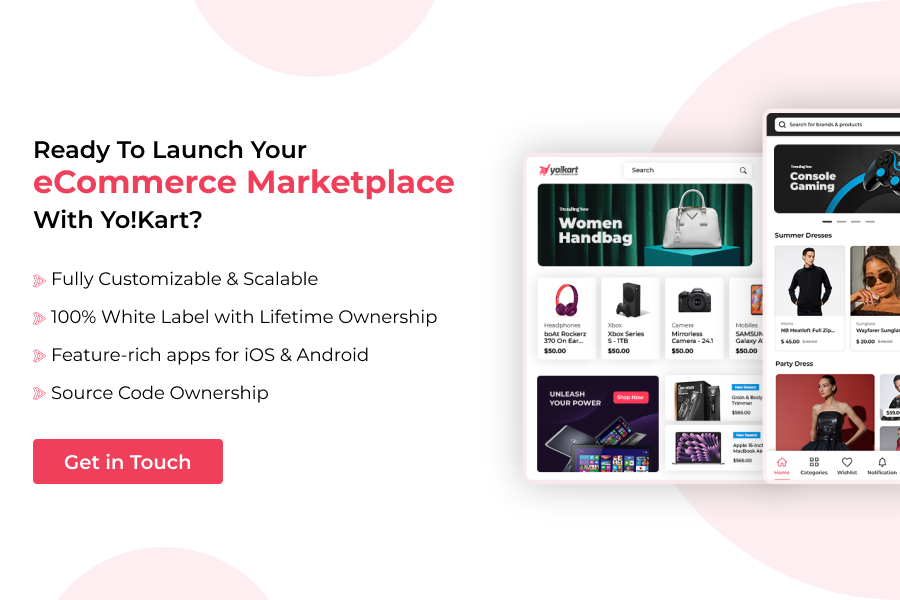Last Updated: 07 October, 2024
The second-hand clothing resale market has experienced massive growth in the last five years with the rising popularity of sustainable and eco-friendly fashion being the primary growth factor. In the year 2023, the overall market was valued at around $70.8 billion and is estimated to grow with a 7.6% CAGR between 2024 to 2032.
The second-hand clothing market is also more affordable for the consumers. It offers an opportunity for buyers to buy clothes from top brands with unique styles at a fraction of the original price. Especially, the young generation is attracted to this trend as it is cheaper for the consumer and greener for the environment. Moreover, the rise of online resale eCommerce platforms and mobile applications has made more easier and reliable for sellers and buyers to sell and buy their pre-loved clothing easily.
In addition, the fashion industry is responsible for a significant amount of carbon emissions. Reuse of the pre-loved clothing can help reduce the greenhouse gas emissions associated with the production of the new clothes. It can also save water, energy, oil, and land by avoiding landfills.
Table Of Contents
- What is a Second-Hand Clothing Marketplace?
- Prominent Players Operating in the Second-Hand Clothing Industry
- Business Model of Second-hand Clothing Marketplace
- Revenue Model for Second-hand Clothing Marketplace
- Essential Features Required to Build a Second-Hand Clothing Marketplace
- Building a Second-Hand Clothing Marketplace
- Select your Development Approach
- Reasons to Choose Yo!Kart for Building your Second Hand Clothing Marketplace
- Final Thought
What is a Second-Hand Clothing Marketplace?
The second-hand clothing marketplace has now become part of the eco-fashion movement as it helps to reduce the environmental impacts of the fashion industry by offering the opportunity to resale pre-loved articles. It attracts people who value the environment and sustainability. In addition to this, the affordability of second-hand clothing and the revolution in eCommerce for online shopping are contributing key factors to the expansion of the second-hand clothing resale market. Therefore, building a marketplace for second-hand clothing can help you grow tremendously as there are endless opportunities in this sector.
An online marketplace for second-hand clothing connects sellers of used clothes and footwear with buyers who are looking for pre-owned fashion items at discounted prices. The marketplace allows the seller to create listings of their used and pre-loved products to sell with detailed descriptions and photos by featuring size, brand, style and price. Again, buyers can browse and shop directly from the marketplace.
Prominent Players Operating in the Second-Hand Clothing Industry
- Depop Ltd.: Depop is a popular UK-based social peer-to-peer (P2P) marketplace with over 30 million active users. It allows users to buy, sell and discover secondhand clothing. According to Statista, Depop’s revenue has grown and reported $85 million last year. Also, the company has received funding of over $100 million from various investors.
- eBay Inc.: eBay is the US-based e-commerce company ranked as the second most visited online marketplace in the year 2023. This platform allows users to list their pre-loved items for sale. In the year 2023, the net annual revenue of eBay was $10.1 billion. It also allows users to bid on the listed products in auctions or purchase them at a fixed price.
- Vinted: An online marketplace specializing in second-hand clothing and was the first tech unicorn in Lithuania. This platform allows users to buy and sell gently used and pre-loved clothes with a focus on sustainability and waste reduction. Vinted has become a popular platform for fashion enthusiasts with over 1 million active users. The company’s revenue has grown significantly and according to Statista, the company’s annual revenue totaled at just over 596 million euros in the year 2023. The massive success of Vinted proves that platforms like second-hand clothing can also grow.
- Poshmark: A leading online marketplace where users and can buy and sell new and second-hand clothing, electricals and other household articles. Poshmark was established in 2011, and its headquarters are in Redwood City and California, US. As a part of the expansion, the company was operating global market. Still, to focus on North America, Poshmark made a difficult decision to close the marketplace in India, Australia and the UK. However, the marketplace drives meaningful growth in its core markets of Canada and the United States.
Want to Launch an ECommerce Marketplace like Vinted and Poshmark?
Business Model of Second-hand Clothing Marketplace
There are three primary user types involved in this second-hand clothing marketplace model which are admin, pre-loved cloth owner or product owner and buyer. They interact with the marketplace in the following manner.
- Product owner lists their pre-loved clothes on the marketplace.
- Buyers browse those pre-loved second-hand clothes.
- The buyer can add products to the cart or proceed to checkout.
- At checkout, the buyer enters the address and other required details and initiates payment.
- The order gets delivered to the buyer.
- When the product owner reaches the minimum threshold amount set by the admin, they can withdraw their earning to the bank account.
- In return cases, the admin reviews return requests including their reasons and product images and takes required action.
Revenue Model for Second-hand Clothing Marketplace
The admin of the platform can generate revenue from multiple revenue channels with zero investment in inventory. There are several revenue models that allow admin to generate revenue:
| Commission on Sale | One of the popular revenue models for the marketplace allows the admin to charge the desired commission percentage on each sale. |
| Subscription Charges | Subscription model admin charges for subscriptions which may vary according to the packages and subscription options. |
| Pay-Per-Click (PPC) | The PPC revenue model allows businesses to promote and rank their product at the top in search and this revenue model admin charges for per click. |
| Banners Promotion | In this revenue model admin charges from the promoters to promote their banner on their marketplace. |
| Display Featured Product on Home Page | The product display feature allows sellers to display their products on the home page by paying some charges to the marketplace for it. |
Essential Features Required to Build a Second-Hand Clothing Marketplace
- Advanced Search and Filter: The search and filter options should be there in the marketplace. It allows user to navigate their relevant searches easily, quickly and accurately by enhancing the overall user experience.
- Easy Sign-up Option- Sign-up or Log-in option on the marketplace is the most vital option from the user’s perspective. Therefore, an easy sign-up option should be there in the marketplace so the user can feel comfortable and initiate further log-in process.
- Listing Management: This feature permits clothing owners to create and manage listings. They can easily add products, upload multiple images, add descriptions, set prices and add discounts by applying specific conditions and other related options.
- User Management: It helps the admin to approve user requests, add users manually, view transactions, send emails and much more.
- Payment Gateways: Multiple payment gateway integration with the marketplace allows users to initiate payments using whatever payment gateway they use. This gives a marketplace owner the opportunity to enable an affordable, safe and quick payment gateway to process transactions with diverse geographic coverage for international payments.
- Withdrawals Interval Period: There should be a withdrawal interval period option. It allows the admin to set up a withdrawal interval period by specifying the frequency at which sellers can request withdrawals. It also helps the admin to set a minimum and maximum withdrawal in days.
- Ease of Shiping: Pre-integrated shipping options like ShipRocket, WasyPOst and ShipEngine allow sellers to manage their shipments with ease. Furthermore, it helps sellers with shipping functions like label printing, address validation, package tracking and more.
- SEO-friendly Marketing: Marketing features allow admin to implement marketing strategies like content marketing, affiliate marketing, email marketing, URL rewriting, meta tag management, and much more. They can even change or update the titles, headings, and sub-headings as per their preferences and marketing options.
- Paid Promotion and Advertisement: Built-in product promotional and advertisement features allow sellers or service providers to promote their products and services to generate more revenue. It also helps marketplace owners generate additional revenue from promotional ads and advertisements.
- Analytics and Reporting: The analytical options provide valuable insights ;and help the admin to analyze, improve and amend required changes. Moreover, it also presents data in a structured format that may include financial, sales, management, marketing and other operational reports.
Building a Second-Hand Clothing Marketplace
Understanding second-hand clothing’s landscape is crucial before you build your marketplace. Let’s have a look at the key factors that you need to consider before you dive into building your marketplace.
- Define Niche: Defining a niche can help you differentiate your marketplace from others. Consider focusing on specific categories, such as vintage clothing, luxury resale and eco-friendly fashion. Your niche will not just guide your branding but also help you build your marketing strategy.
- Target Audience: According to your niche, value and the demand of the industry, you need to find your target audience. It helps you to build effective marketing strategies to target potential audiences.
- Monitor Trends – Understanding the trends of the industry is also one of the crucial key factors. It provides valuable insights into the customer’s need and their preferences.
- Analyze Competitors – Doing research on existing prominent players in the market can help you find the gaps in their offerings. It will allow your marketplace to fill the gap and build a different identity in the market.
- Revenue Model: Decide how you want to operate your marketplace. It will reflect your revenue and guide how sellers will perceive your platform. The common revenue model includes:
a. Commission-based
b. Subscription-based
c. Listing Charges
d. PPC & Sponsored Ads
Select your Development Approach
To launch a second-hand clothing marketplace there are two popular approaches available. The first one is a custom development approach and the other is a Turnkey/ready-to-use solution. Let’s explore each approach for building a second-hand clothing marketplace before you start:
Custom Development Approach: In the first approach, you need to develop a marketplace from scratch which can be a little tough and time-consuming. You need to set up or hire a team of experts for coding, development, designing, etc. with industry experience. This process ideally takes six months to one year to deliver a basic MVP.
In addition to this, you can’t ignore the necessary expenses of APIs or third-party app integration for payments, shipping, additional features, functionalities and much more. In short, custom-made solutions are not for entrepreneurs who want to get a cost-effective and time solution for a quick start.
Readymade Solution: On the other hand, building a second-hand clothing marketplace with an alternative like a turnkey solution can help you bypass the additional time of building the marketplace from scratch. Depending on the solution solution you choose for your marketplace.
There are two primary options for readymade solutions, the first one is SaaS-based, this solution provides features based on the subscription packages which may vary with the packages. While others are self-hosted solutions which are fully customizable and scalable. They come with the all essential features that a marketplace needs to run a business model. They are ready-to-use and time-tested solutions that give you a quick start. Moreover, they are one of the cost-effective approaches in the long run.
Reasons to Choose Yo!Kart for Building your Second Hand Clothing Marketplace
Yo!Kart is a leading eCommerce marketplace platform that allows businesses or enterprises to build and manage their online marketplace. It is a white-label solution that can help you get a seamless start for your online second-hand clothing marketplace. With 10+ years of industry expertise, Yo!Kart has empowered 5000+ businesses from 100+ countries. Its comprehensive eCommerce solutions allow you to launch your second-hand clothing marketplace without technical expertise.
The intuitive and easy-to-use interface of Yo!Kart helps users including admin, sellers and buyers to complete their roles with minimal effort. Admin can easily manage data, customize the marketplace, create a master catalog, check analytics and reporting, and much more. Sellers can easily list their products without having any expertise with its self-explanatory design. In the same way, buyers can also browse, add to cart, purchase and track consignment without putting extra effort.
From user-friendly interfaces to extensive customization options, Yo!Kart can significantly reduce the time and effort required to launch your second-hand clothing marketplace. It also allows businesses to implement their own comprehensive strategies by customizing the platform to lead the eCommerce landscape according to their preferences using source code.
Launching your secondhand clothing marketplace has never been easier. But with ready-made solutions like Yo!Kart, you can launch your online marketplace in no time.
- Yo!Kart is a self-hosted solution that gives you the flexibility to host the marketplace on your own server, improving speed and security.
- Yo!Kart is a ready-made solution that doesn’t require coding to launch your marketplace.
- It comes with source code that allows businesses to customize their marketplace if any additional functionalities are required.
- Yo!Kart allows you to scale your marketplace in order to expand your business and eliminate the need for migrations without disruption.
- One time payment option of Yo!Kart enables the opportunity to get a lifetime license ownership with no recurring charges. One-time Payment
- With Yo!Kart you will get one year of technical support for any unexpected bugs and errors.
- Yo!Kart’s 20+ payment gateways accommodate a wide range of payment options and minimize the chances of delayed payment.
Build Your Second-Hand Clothing Marketplace with Yo!Kart
Final Thought
The rise of sustainability and consciousness towards the environment has given birth to a successful second-hand clothing market. Therefore, building a second-hand clothing marketplace is not just a business venture but a chance to contribute to a more sustainable future. By understanding the market, defining your niche, and utilizing a robust and readymade solution like Yo!Kart, you can create a platform that connects conscious consumers with unique and pre-loved items. Yo!Kart comes with a one-time payment option for lifetime license ownership with one year of free technical support. The added benefit of ongoing support and updates allows you to focus on what really matters.




